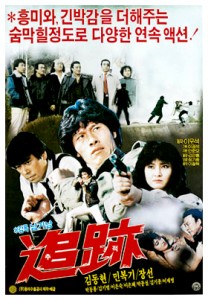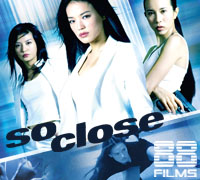Director: Lee Tso Nam
Writer: Cheung San Yee
Producer: Lim Kee Chye
Cast: Chen Shan, Don Wong Tao, Eagle Han Ying, Ching Kuo Chung, Peng Kang, Ho Hing Nam
Running Time: 90 min.
By Paul Bramhall
Taiwanese director Lee Tso Nam should be a name recognizable to anyone who considers themselves a fan of kung fu cinema. Active in the industry since the early 70’s, and still active today, he’s the man behind countless classics of the genre. Be it old-school kung fu (The Hot, The Cool, & The Vicious), Bruceploitation (Exit the Dragon, Enter the Tiger), fantasy (Kung Fu Wonder Child), and even Girls with Guns (Beauty Investigator). If you think you’ve never seen a Lee Tso Nam movie, chances are you have, but you just haven’t realized it.
Tso Nam was also the director of Shaolin Vs Lama, a title many fans consider to be a bonafide classic of the genre. Featuring Chang Shan, who delivers a fantastic villainous turn as the leader of the Eagle clan, he and Tso Nam would become regular collaborators, and just a year later would get together again to make Wild Panther. For good measure, they also brought onboard the choreographer of Shaolin Vs Lama, Peng Kang. Far from being another old-school kung fu movie, Wild Panther is a modern day action movie, and was in fact a co-production between Taiwan and South Korea.
Chang Shan himself is a Korea born Chinese, and spent most of his formative years living there, so in many ways the production provided him with an opportunity to return to his birthplace. Notably he would go on to feature in another Taiwan and South Korea co-production later on in his career, in the 1993 movie Rendezvous of Japanese Kanto. Wild Panther also stars another one of Tso Nam’s regulars, Don Wong Tao, however apart from Tao’s presence the key players are all Korean, and the movie was shot almost entirely on location in Korea.
Part of the appeal of Wild Panther is seeing some of the familiar faces of the old-school Korean kung fu scene in a modern day action flick. Eagle Han Ying, who was usually cast as a villain in the likes of Champ Against Champ and Magnificent Wonderman from Shaolin, here plays a one armed leather jacket wearing villain. He answers to Park Dong-yong, who almost always played villain roles in the likes of Hard Bastard and Secret Executioners. Chang Shan himself is teamed up with Peggy Min Bok-ki, who starred in the likes of Strike of Thunderkick Tiger. The factor which ties all of their characters together, is that they all served in the Vietnam War, were Shan and Bok-ki were part of an anti-crime unit called the Wild Panthers. It was during the war that Shan sliced off Han’s arm, which is shown rather graphically in a brief flashback.
The dubbing seems to make the plot slightly confusing though. Through dialogue it’s explained that everyone is after a list, which has the names of organized crime syndicates and the people working for them. Wong Tao is sent to Korea to find it, Eagle Han and Dong-yong are also after it, and Shan and Bok-ki get caught in the crossfire when it appears the list inadvertently ends up in their hands. The only problem is, the movie opens with a character drawing a map of a temple before being murdered, and it’s this map which is being passed around. What’s this list of organized crime syndicates!? As it turns out, the list is actually on a couple of negatives, while the map is a different plot point all together. I guess the dubbing team decided that “a list stored on a couple of negatives” didn’t roll off the tongues as easily as just “a list”.
The list/map isn’t the only thing the dubbing seems to play fast and loose with. In another scene Wong Tao and Shan agree to talk at the police station, and in the next scene they’re in an abandoned fairground together. Audiences who like their plots to be coherent need to either leave their brain at the door, or find the original language version for this one. The scene in the fairground is significant though, as apart from the opening scene, Wong Tao goes missing for a large portion of the runtime. His meeting with Shan sees him return to proceedings around the 55 minute mark, and a misunderstanding between them triggers a fantastic fight between the pair.
What’s unique about the fights in Wild Panther is the way they’re grounded in reality. Shan and Wong Tao’s showdown is an intense explosion of fists and feet, however within a minute they’re both on the ground exhausted, carelessly throwing fists at each other and attempting to stagger back onto their feet. It’s rare for a kung fu movie, even one set in modern day trappings, to display such realism, with fighters usually going at it for several minutes at a time with no sign of exhaustion. It certainly adds a welcome element of realism, as well as a sense of desperation, making the outcome of the fight seem less certain. The only other movies I can recall which display a similar sense of realism are Black Belt, and of course Sammo Hung’s Enter the Fat Dragon, when he humorously stops mid-way through the finale to catch his breath.
Budgetary constraints certainly show up in some areas though, particularly during the shootout scenes, which seem to pay no regard to the positioning of the shooters and those being shot at. In one scene I swear Shan is shot point blank in the head, however he’s either impervious to bullets, or we’re just supposed to presume that the bullet missed. Overall though these small quibbles aren’t enough to derail Wild Panther, and the movie reels itself back in for an impressive finale set in the woods. If I was to make a comparison, I’d say the same way people say Eastern Condors is an Asian version of Rambo: Fist Blood Part 2, then it could also be said that the finale of Wild Panther is the Asian version of First Blood, made a couple of years earlier.
Decked out in his army fatigues, Shan sets up a host of booby traps, which range from spikes to trip wires. Bok-ki also joins in the fray, and it would be a crime not to mention her fight scene which has one of the coolest sword concealments I’ve seen. Shan uses everything from grapple hooks to daggers in order to take out the enemy, and there’s some great use of slow motion in the sequence. One particular part has him running towards the camera, as explosions go off on either side of him, in a scene which predates similar sequences in the likes of Dreaming the Reality and Hard Boiled by a whole decade. Throw in liberal use of grenades and firepower, and in many ways the finale could be viewed as the template for many of the pyrotechnic filled Girls with Guns flicks that would flood the market in the early 90’s.
All of the bullets and explosions culminate in an intense showdown between Shan and Han, which has the two of them going at it with their fists and feet in a fight that makes great use of their surroundings. The pair are flung into ditches, against trees, and down hills in a confrontation which is suitably violent. While fans of Dong Tao may be disappointed that his role in Wild Panther remains largely peripheral, there’s no doubt that this is Chang Shan’s show, and to see him in a rare leading good guy role, ensures that it definitely warrants a watch.
Paul Bramhall’s Rating: 7/10





Oh,. this sounds really good, dude!!! Another great review! You’re really bringing out some good Korean flicks lately.
This is how I remember this movie:
🙂